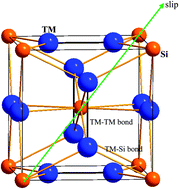The adjustment of the balance between strength and ductility is still a great challenge for ultrahigh temperature materials. Essentially, the strength depends on the valence electron density of transition metals and the bond strength of chemical bonding. However, the ductility of a solid is mainly determined by the symmetrical slips and crystal structure. Based on the above design principles, we apply first-principles calculations to investigate the structure, elastic properties and brittle-or-ductile behavior of TM3Sis with a cubic structure. Two new TM3Si structures: Ti3Si and W3Si (space group: Pm![[3 with combining macron]](https://www.rsc.org/images/entities/char_0033_0304.gif) n) are predicted. The calculated results show that W3Si exhibits strong volume deformation and shear deformation resistances in comparison to TM5Si3. In particular, W3Si also exhibits excellent ductility due to the symmetrical structure. The calculated electronic structure reveals that a high elastic modulus derives from the strong and symmetrical W–Si and W–W bonds. Therefore, we can control a crystal structure with symmetrical slips and choose a TM metal with a high valence electron density, to improve the correlation between ductility and strength.
n) are predicted. The calculated results show that W3Si exhibits strong volume deformation and shear deformation resistances in comparison to TM5Si3. In particular, W3Si also exhibits excellent ductility due to the symmetrical structure. The calculated electronic structure reveals that a high elastic modulus derives from the strong and symmetrical W–Si and W–W bonds. Therefore, we can control a crystal structure with symmetrical slips and choose a TM metal with a high valence electron density, to improve the correlation between ductility and strength.
